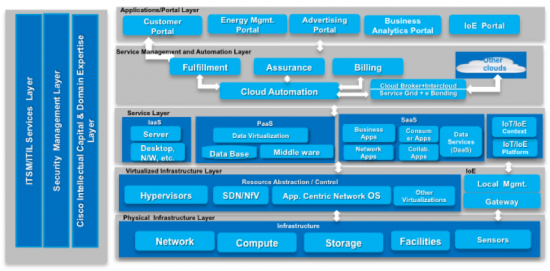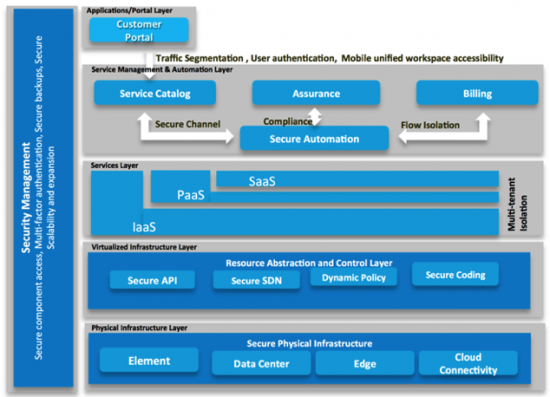This is part 2 of the “Your Business Powered By Cisco Customer Solutions Architecture (CSA)” blog series.
CSA Description
The following figure shows a simplified view of the Cisco CSA. It has five horizontal layers: Physical Infrastructure layer, Virtualized Infrastructure layer, Services layer, Service Management and Automation layer, and App/portal layer. Supporting each layer from top-to-bottom, there are three vertical layers: ITSM/ITIL services layer services enablement, Security layer for providing security across each of the horizontal layers, and Cisco Intellectual and domain management layer for providing Cisco best practices at each of the horizontal layers.

This CSA is a logically layered architecture (LLA), with each layer providing a distinct function. The model is designed in a hierarchical fashion with devices and facilities at the bottom, customer interactions at the top, and various required functionalities in the middle layers. The key to this model is the abstraction of each layer into software-defined components with standardized interfaces. Similar to other LLA models such as ITU-T TMN (Telecommunications Management Network), each horizontal layer supports the layer above in performing its business functions.
CSA Layered Approach
The interaction between various layers is through abstraction, orchestration, and API’s. The customers’ requests are processed from the top layer where orchestration fulfills the various components and provisions into the infrastructure using the API’s between the layers. Similarly, the assurance information (SLA’s, events, resource constraints, etc.) and metering/billing are bubbled up to the higher layers through automation and API’s for dashboard displays and reporting. Working from the top down, each layer imposes requirements on the layer below. Working from the bottom up, each layer provides capabilities to the layer above. For example, at the top CSA layer, the customer requests services that are provisioned using the automation layer and API’s that interact with the services layer, virtualization layer and physical layer below it. However, It should be noted that the LLA does not force every function to go from one layer to the next layer in the physical sense.
The CSA is comprised of horizontal and vertical layers. Horizontal CSA layers cover:
- Applications
- Service management for fulfillment, assurance, and billing.
- Cloud services (IaaS, PaaS and SaaS)
- Virtualized resources (compute, network, storage) consumed in the production of the service
- Physical resources (compute, network, storage, facilities and IoE sensor networks)
The vertical layers represent top-to-bottom functional areas. These vertical layers span all horizontal layers to support business processes and manage IT operations. The vertical layers cover:
- ITSM/ITIL services for enabling the cloud services. The ITIL processes and best practices play a critical role for setting-up the back office operational processes.
- Security services at each layer to deliver secure cloud services to end customers. It should be noted that security also exists in each horizontal layer as well.
- Cisco Intellectual Capital and domain knowledge at each layer, based on Cisco experience and expertise, to assist the delivery of IT services and maintain the required SLAs. It also serves to provide support services for services optimization.
The following image provides a more detailed view of the functionality within and between CSA layers.

This next image depicts the security aspects of the CSA while the section that follows provides additional details on the security capabilities within each Cisco CSA layer.

In my next blog, I’ll explain the role of each of the Cisco CSA layers.
Tweet me @CiscoSP360 if you have any questions or comments.

CONNECT WITH US